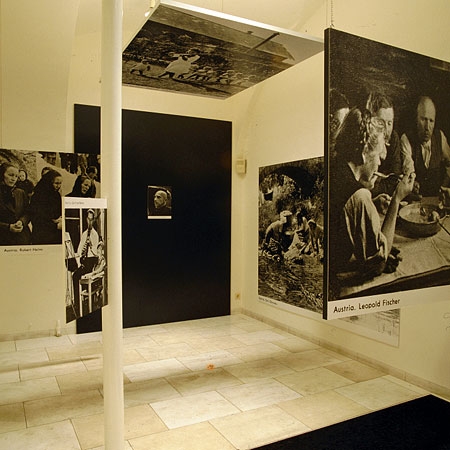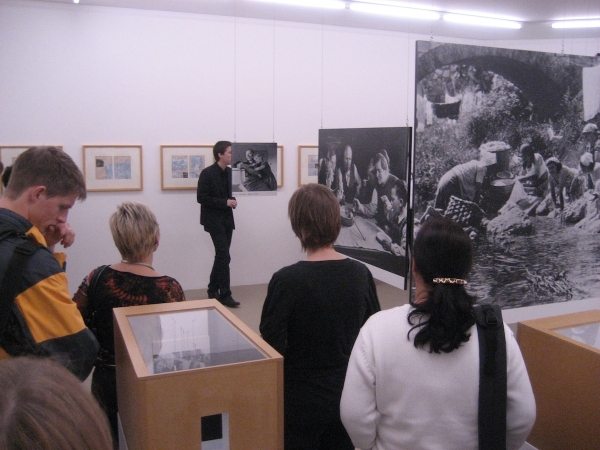
Installation view, room 3, Galerie Metropol, Vienna, 1993
Installation view, room 2, Galerie Metropol, Vienna, 1993
Installation view, room 1, Galerie Metropol, Vienna, 1993
The Family of Austrians
19 October – 30 November 1993
Galerie Metropol, Vienna
Display Window:
– “The Family of Austrians,” 1993, reworked exhibition catalogue “The Family of Man” (1955), linen slipcase, embossed; Sammlung Karola Grässlin
Room 1:
– “The Family of Austrians 1:10, A,” 1993, model on base, MDF, painted; Plexiglas, seven black and white photographs, adhesive letters, wire; total dimensions: 51 x 27 x 15 inches; Ernst Ploil, Vienna
– “The Family of Austrians 1:10, B,” 1993, model on base, MDF, painted; Plexiglas seven black and white photographs, adhesive letters, wire; total dimensions: 51 x 27 x 15 inches; Georg Kargl, Vienna
Room 2:
– “Untitled,” 1993, black and white photograph, passe-partout, framed; edition of three; 20 x 22 inches
– “Untitled,” 1993, table made of pear wood, linoleum, steel, mail order catalogue (traditional fashion, 1993 season); 71 x 39 x 37 inches
– Three display cases with traditional Bregenzerwälder women’s costumes; collection of the Institute for Costume Studies, Hochschule für Angewandte Kunst, Vienna
– Monitor with two educational films about traditional women’s costumes from Bregenz by Annemarie Bönsch; Österreichisches Bundesinstitut für den Wissenschaftlichen Film, Vienna
Room 3:
– “The Family of Austrians,” 1993, installation: seven black and white photographs, enlarged; 275 x 153 inches; Ernst Ploil, Vienna
In Christian Philipp Müller’s exhibition “The Family of Austrians,” bright red panels concealed three display windows of the Galerie Metropol on Dorotheergasse in Vienna. No indication was given in terms of what awaited visitors on the interior, only the oversized lettering of the artist’s name, the title, and the dates of the exhibition punctuated the red surfaces. In the gallery, viewers encountered various representations of Austrian national culture. As in his contribution to the Austrian pavilion at the Venice Biennale of the same year, Müller explored the image and self-image of the nation. In this case, Austrian architect Adolf Loos as well as Edward Steichen’s New York exhibition “The Family of Man” (1955) provided Müller with points of departure.
In his 1898 essay “Wäsche,” Loos had observed how a traditional costume functioned in social structures, taking the costume’s association with the anti-urban, rural, and retrogressive as occasion for a stylistic investigation. In Müller’s exhibition, Austrian costumes from Vorarlberg were displayed in vitrines. Along with them, he showed the manufacturers’ instructional films which explained the composition and production of the fabric and its draping on the body as well as sales catalogues for contemporary costume fashions that praised the traditional and folkloric as an authentic, unbroken idyll.
In the publication for “The Family of Man,” Steichen had compiled 503 photographs from 68 countries in an encyclopedic study of world ethnography. From these, Müller extracted seven depictions of Austrians. In contrast to Steichen, who strove for a complete ethnographic survey of humanity, Müller isolated a “national family.” And although the photographs were made in the nineteen-fifties, the scenes they showed were thoroughly folkloric, rurally austere, and retrogressive. Müller reconstructed a fragment of Paul Rudolph’s exhibition structure from the Museum of Modern Art in New York, at that time the first station of the large traveling exhibition. Ranging from small, intimate pieces to over-life-size black and white panels, the images hung vertically in the space and horizontally under the ceiling, determining the visitors’ direction of movement and integrating them into the structure of the exhibition. In Müller’s exhibition, Steichen’s evolutionary history returned as a collection of antiquated stereotypes. In two models on a scale of 1:10, Müller recombined a quote from Edward Steichen, “People should feel they are looking into a mirror when they see the exhibit — as the basic purpose is to show how alike we all are, from Bombay to Boston” with the seven photographs. The eight exhibition elements could also have been configured in countless other ways. As in Steichen's “Family of Man,” Müller's “Family of Austria” consists of the relationships established between its elements.


